

TLT15 C Spalding - Teaching and learning resources to magpie. Practice Shared by Colleagues @sheffcol 16/17. Engagement. Over the years, I have seen engagement take a variety of forms.

When I first began teaching, I was an Associate Lecturer and was therefore handed whatever bits and pieces the College I worked in at the time couldn’t get covered by other members of staff – NEET (Not in Education, Employment or Training) groups on employability courses, Functional Skills classes at odd times of the day or week (Saturday mornings anyone?) And on other sites. With the majority of these groups, engagement was the main purpose- re-engaging them in education, re-engaging them with English, maths and ICT, re-engaging them with learning in general (making the assumption that there had been a time when they were engaged to begin with). Dylan Wiliam - 5 Formative Assessment Approaches. READING - Doug Lemov - Cold Call is Inclusive. Waiting to be Engaged?
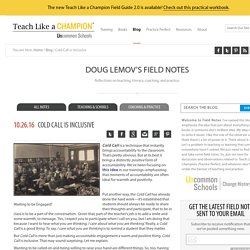
Cold Call is a technique that instantly brings accountability to the classroom. That’s pretty obvious. But at its best it brings a distinctly positive form of accountability. We’ve been focusing on this idea in our trainings–emphasizing that moments of accountability are often ideal for warmth and positivity. Put another way, the Cold Call has already done the hard work—it’s established that students should always be ready to share their thoughts and participate, that to be in class is to be a part of the conversation.
READING - Involving students in assessment conversations. For students to be actively engaged in their own learning journey, they need to know what they are learning, why they are learning it, how to learn it, how well they are learning it, and how to take the next steps to advance their learning.

VIDEO - Dylan Wiliam - The Classroom Experiment: lollipop sticks. READING - Collaborative learning - Research summaries. 'If individualistic learning dominates your classroom, your students will behave accordingly, even if you put them temporarily into cooperative groups.' Johnson, Johnson and Holubec (ASCD 1994) Teachers need to control less In collaborative learning the role of the teacher changes.

Although pupils become the crew rather than the passengers, the teacher still remains the pilot, setting the classroom on course and ensuring that the pupils work and learn together effectively. Paradoxically, the less controlling the teacher, the better the students will perform. READING - What Does Research Say About Assessment? R.J.
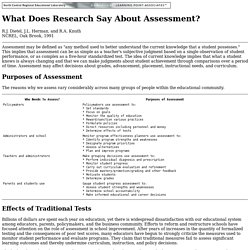
Dietel, J.L. Herman, and R.A. KnuthNCREL, Oak Brook, 1991 Assessment may be defined as "any method used to better understand the current knowledge that a student possesses. " The Retrieval Roulette – A Chemical Orthodoxy. A lot of people on Twitter have recently been talking about the importance of mini-quizzes and how they are carried out.
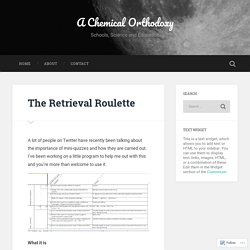
I’ve been working on a little program to help me out with this and you’re more than welcome to use it. What it is A simple Excel program that uses a list of questions and answers to generate a random 10 question quiz. You can set it to ask 5 questions from any point in the course and 5 questions from the current topic (this is what I do). READING - The Perfect Assessment. The Perfect Assessment by Terry Heick Nothing is perfect, but we can dream.
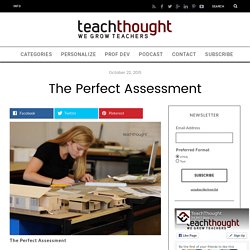
So let’s dream about assessment. First, what is an assessment? A measurement? If the goal of our collective craft is understanding, than the tools we use should promote understanding, both directly and indirectly. So what would the perfect assessment be like? READING/ RESOURCES - Behaviour Management. READING - Relationships. This series of #backtoschool blogs summarises much of my thinking as it’s developed over the past few years and is aimed at new or recently qualified teachers.

Each area has been distilled to 5 ‘top tips’ which I hope prove useful to anyone embarking on a career in teaching. That said, I’ll be delighted if they serve as handy reminders for colleagues somewhat longer in the tooth. Ten Questioning Strategies. “The wise man doesn’t give the right answers, he poses the right questions.”
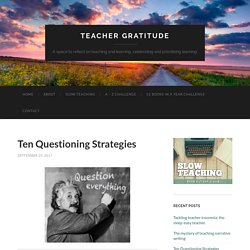
Claude Levi-Strauss Einstein would be rather chuffed: I have spent the last two weeks questioning everything about my approach to questioning in the classroom. Having written about the questioning traps that I kept finding myself stumbling into with new groups, I have made developing questioning in the classroom my pedagogical mission for this year.
To narrow this mission down, below are the ten strategies I will be focussing on: 1. (a) Teacher question: Pose the question then pause. Engagement: Just because they’re busy, doesn’t mean they’re learning anything. – chronotope. I’ve long thought that one of the weakest proxy indicators of effective learning is engagement, and yet it’s a term persistently used by school leaders (and some researchers) as one of the most important measures of quality.

In fact many of the things we’ve traditionally associated with effective teachers may not be indicative of students actually learning anything at all. At the #ascl2015 conference last Friday, the always engaging Professor Rob Coe gave a talk entitled ‘From Evidence to Great Teaching’ and reiterated this claim. Research Based Training - Proven Impact - Thinking Reading. Clear Teaching (Shepard Barbash 2012): Education Consumers Foundation This short book effectively outlines the development of Direct Instruction, its core principles, what it looks like in practice and how it is supported by a large body of evidence.
Go to PDF → What is Direct Instruction? (from Exceptional Children: an introduction to special education) (Heward W L 2000) Retrieved from wps.prenhall.com. Center for Teaching and Learning. Research has demonstrated that engaging students in the learning process increases their attention and focus, motivates them to practice higher-level critical thinking skills and promotes meaningful learning experiences. Instructors who adopt a student-centered approach to instruction increase opportunities for student engagement, which then helps everyone more successfully achieve the course’s learning objectives.
Flipping the classroom. Two Cold Calls from the First Days of First Grade. This morning we watched two great clips of first grade teacher Jennifer Crucetti Cold Calling her first graders on the second day of school at Abram Lansing Elementary in Cohoes, NY. Cold Call, as you may know, is a hugely powerful tool in the classroom when it’s a normal and positive part of the lives of students. When a teacher calls on students whether or not they’ve raised their hands, she builds a culture where everyone is included and invited into the conversation—even the shy kids. And she builds a culture where everyone is accountable for what happens in the lesson—even those who might otherwise tune out. It allows a teacher to check for understanding by steering questions to just the right student.
And it allows her to control the pacing of her lesson—speeding up or slowing down exactly as she wishes. Engage for Progress - Slides. READING - A to Z of... Group Work. Starting with B for behaviour, this video takes an alphabetical journey through the key issues affecting group work, featuring 13 teachers who share their strategies for success, in ‘The Secondary A-Z Of...’ How important are attainment levels when it comes to choosing your groups? Is there an appropriate time to let students work in friendship groups? How do you decide when to intervene and when not to? Are there ways of controlling the noise? READING - Top Ten Group Work Strategies. If I am continually vexed by any one question in education it is ‘how can we enhance student motivation?
‘ Of course, I do not have the answer, and if there is one it is multi-faceted, complex and, frankly, not going to be solved in this blog post! From my position as a classroom teacher, I am always on the look out for those strategies that create a state when students are motivated and in their element, where they work furiously without even realising they are doing so, without realising the clock is ticking down to the end of the lesson. There is no better compliment than when students question how long there is left and express genuine surprise at how fast time has passed, and that they have actually enjoyed that lesson!
My, admittedly non-scientific, observations are that many of the times students are in ‘flow‘, or their element, in my lessons is when they are collaborating in group work. RESOURCE - Group Role Cards. VIDEO - Jim Smith - No Hands Up & No Hiding. READING - Group Work: An Essential Guide. Many people herald the wisdom of crowds, but ask a teacher about crowds of students and they will tell you a different tale that is often characterised by the polar opposite of wisdom. Great group work in the classroom can similarly prove a boon or a burden for hard working teachers. STUDENT ACTIVITY - Record Your Own Starters/Plenaries. STUDENT ACTIVITY - 9 Ways To Get Students Up & Moving. STUDENT ACTIVITY - Progress Review.
READING - Level up Questioning. VIDEO - Target Setting and Measuring Progress. STUDENT ACTIVITY - 53 Ways to Check for Understanding. READING - Introducing pace and purpose into your lessons. Adopting an appropriate pace has always been an important component of a successful lesson, particularly with groups of high-achieving pupils who are more than able to cope with at least an hour of rigorous challenge.
These pupils thrive on the demands of a lesson that asks them to move quickly through exposition and review to get to new learning points and to spend time developing and extending new ideas and concepts. However, it is extremely tempting to think of a lesson with ‘unrelenting pace’, where pupils are constantly engaged and productive all the time, as being a successful learning experience. I have observed numerous ‘all singing, all dancing’ lessons where pupils have barely had time to breathe before the next activity was presented to them.
They work on the notion that if pupils are simply too busy to misbehave then the lesson is likely to go more smoothly. The planning stage Ask yourself who is it that you want to work harder – the pupils or you? The core phase of the lesson. READING - Co-Constructing Success Criteria. READING - Level up Pre-Assessment. READING - The 20%: Questioning. This is Part One of a new 2-part blog exploring effective questioning in the classroom.In a previous post I talked about the Pareto Principle. I suggested we should focus on improving the 20% of classroom strategies which research shows yield 80% of results. In other words, we should focus on practising those interventions which most expedite student progress.I have already written about the role feedback can play.Now I shall turn my attention to questioning… Questions are bread-and-butter stuff for teachers, a way of extending students’ learning, fostering a sense of curiosity, and assessing the progress being made (or not) by our students.
But not all questions are equal… In an article written as long ago as 1985 – in the days before the National Curriculum and Assessment for Learning, Jos Elstweet observed a lesson and made the following comments: READING - Questioning and Feedback: Top Ten Strategies. READING - Questioning and Oral Feedback - Our 'Bread and Butter' #techtuesday - Cornerstones Engage.